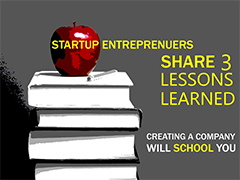Startup Lessons from Entrepreneurs

Entrepreneurs share challenges they overcome through 3 startup lessons
Every entrepreneur sets out to build something unique and special in the market, but with each step they take comes an array of highs and lows. As active members of our startup community, we speak with entrepreneurs incessantly. We have had the pleasure of hearing some of the most unique and inspiring startup lessons they’ve learned along their journeys. Here are 3 lessons that stood out from the crowd.
1. Building the Right Team
When beginning a startup company, finding the right team members is crucial. One overlooked mistake is hiring people for their personality fit and affordability alone. That’s only one piece of the puzzle. With long hours and obstacles ahead, building your team means finding people with the ambition to push through tough times and the skill sets to complement and challenge those already at the company. This notion became quite evident to the founder of a new alumni engagement startup.
The biggest challenge we faced early on was finding the right CTO. We spent a lot of time looking for someone that would balance out the needs of our team. Having a team with complementary skills is one of the most important pieces a startup needs. There are invariably a dozen other people with a similar idea to ours, but because of the variety of experiences and capabilities on our team, we can turn our rock star product into a rock star business.
–Nick Zeckets, CEO of Quadwrangle
When building your startup’s team, it’s important to think about trust and credibility. Ask friends and others in your professional network for recommendations. Go to networking events and talk to as many people as possible. The process may seem cumbersome, but don’t settle until you’ve found the right people to add to your ‘family’ and move your startup forward.
2. Pricing your Product
Determining the price for your startup’s product can be tricky, especially when you have no direct competitors to benchmark against. Changing the price once you have already established customers can be even trickier. This was especially true for the founder of an innovative billing startup.
When I joined Chargify, the product was priced much too cheaply. We quickly realized we were losing money at this price point. The first time we raised prices, we didn’t prepare our customers. We didn’t communicate the price increase well enough and with enough advance warning, and that created a lot of friction with our clients.
The second time we raised prices, I wrote a blog post 6 or 7 months in advance and directly contacted over 100 clients to let them know about the price increase. Even though our second price increase was proportionately higher than the first, we had a much smoother transition because we were open with our customers from the beginning.
–Lance Walley, CEO of Chargify
When determining the right price for your product, it’s important to do market research first. Ask as many people as possible what value they would place on your product. If you’ve found that your price point just isn’t scalable, having an open dialogue with your existing customers well ahead of your price increase will allow them to make more rational decisions about whether to go or stay.
3. Developing your Messaging & Positioning
Determining the right message that resonates with your target audience can be challenging. To some startups, it’s a matter of trial an error, but it doesn’t need to be. Getting to know your target market will significantly help in attracting them to your product. This rang true for the founder of a publishing software startup.
I struggled with a way to convey clearly to editors, our target audience, that my product would help them do their jobs better. We faced a lot of obstacles in the beginning, approaching editors and quickly finding rejection. We decided to move our offices into the newsroom of the New York Daily News for a year. We literally sat among hundreds of reporters and editors every day. We got to know our target customers at a level only few could have hoped for, and this was pivotal in gaining traction for our product.
–Dennis Mortensen, CEO of Visual Revenue
Spending time with your target customers and listening to their pain points is the key to developing your startup’s messaging & positioning. Not everyone can move in to the same office space as their target market, but there are things you can do to become more informed. Spend time attending events where your target customers will be. Read what they’re posting on social media. If you have the time, conduct market insight interviews, and explicitly ask questions that will illicit the language you need to make your product sound more compelling and attract their interest.
Which of these startup lessons resonates most with your current challenges? Do you have your own to share? We’d love to hear from you on Twitter, using our handle @_Magnetude and hashtag #startuplessons.
If you’d like to learn more about how to overcome these common yet crucial challenges, contact us today.